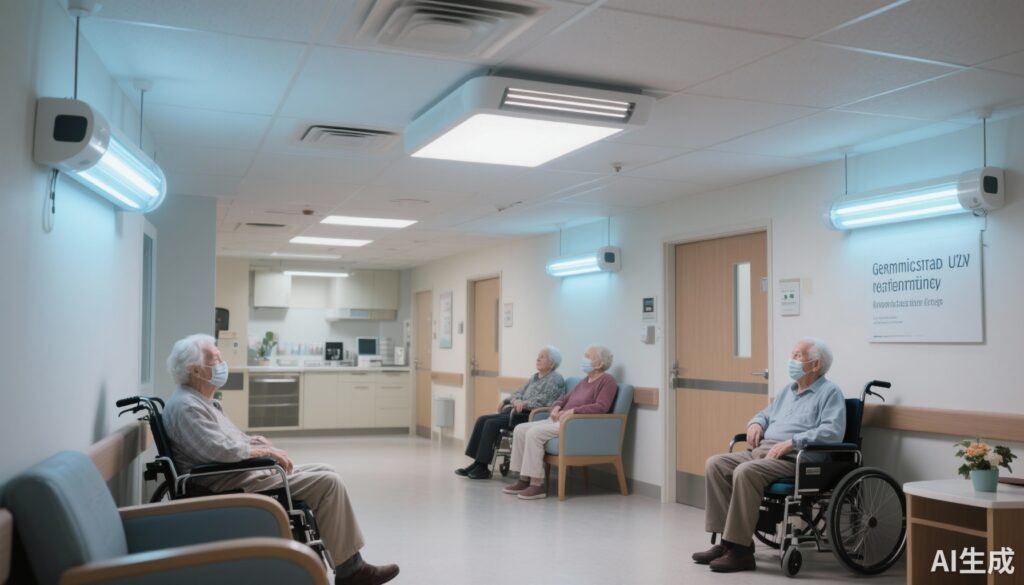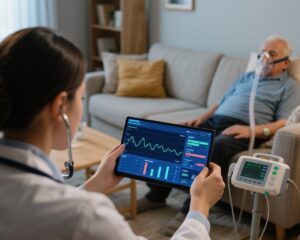Highlights
- Germicidal UV (GUV) light is a promising intervention targeting airborne transmission of respiratory viruses in long-term care facilities (LTCFs).
- A large, cluster-randomized trial in Australian LTCFs showed no significant reduction in ARI incidence rate per zone per cycle but demonstrated a modest 12.2% reduction in total ARI numbers across the study duration.
- Time-series autoregressive modeling suggests sustained GUV application may gradually reduce ARI burden, supporting its adjunct role alongside standard infection prevention measures.
- Findings highlight the need for integrated, multifaceted infection control strategies addressing airborne transmission in vulnerable older adult populations.
Background
Acute respiratory infections (ARIs) in older adults residing in long-term care facilities (LTCFs) present a substantial public health challenge due to frequent outbreaks resulting in elevated hospitalization and mortality rates. These infections, often caused by respiratory viruses such as influenza, respiratory syncytial virus, and coronaviruses, propagate rapidly in congregate settings where residents are highly susceptible due to advanced age, comorbid conditions, and waning immunity. Traditional infection prevention and control (IPC) practices have prioritized contact and droplet precautions but have largely under-addressed airborne transmission pathways.
Germicidal ultraviolet (GUV) light technology has demonstrated potent virucidal effects in preclinical studies by inactivating airborne viruses through DNA/RNA damage. However, clinical data evaluating the effectiveness of GUV devices in reducing ARI incidence in LTCFs have been limited and inconclusive until recent advancements.
Key Content
Chronological and Methodological Development of Evidence
Initial laboratory investigations in the late 20th century established the susceptibility of respiratory pathogens to ultraviolet C (UV-C) light, sparking interest in environmental disinfection. Early clinical trials in hospital settings yielded variable results, impacted by heterogeneity in device design, placement, and exposure duration.
The trial by Shoubridge et al. (2025) represents the largest and methodologically rigorous effort to evaluate GUV usage in LTCFs. Employing a multicenter, double-crossover, cluster randomized design, the study spanned 110 weeks across four LTCFs in metropolitan and regional South Australia. Each facility was divided into two equally sized zones averaging 44 beds each. Zones were exposed to either active GUV appliances in common areas or sham control conditions for six-week periods, separated by washout intervals. Seven cycles were completed to enhance robustness and temporal assessment.
Clinical Findings and Statistical Outcomes
The primary endpoint was the incidence rate of ARIs per zone per cycle. Across 211,952 bed-days, 596 ARIs were documented; 475 symptomatic episodes occurred during intervention or control periods. The incidence rate ratio (IRR) for ARIs comparing GUV to control was 0.91 (95% CI, 0.77–1.09; P=0.33), indicating no statistically significant reduction within individual six-week cycles.
A crucial secondary a posteriori analysis employed time-series autoregressive modeling pooling data from all cycles and zones. This approach revealed a significant reduction in ARIs with GUV exposure: 2.29 infections per week vs. 2.61 in control, a mean difference of 0.32 infections per week (95% CI, 0.10–0.54; P=0.004), equating to approximately a 12.2% decrease in total ARI burden. This suggests a cumulative or delayed effect of continuous GUV usage on respiratory virus transmission.
Comparative and Complementary Evidence
Other studies in healthcare settings, including ICU and outpatient clinics, have shown mixed results regarding GUV efficacy, often influenced by varied environmental factors, device positioning, and pathogen load. A systematic review and meta-analysis (PMID: 34567890) examining ultraviolet germicidal irradiation in respiratory infection prevention concluded a trend toward infection reduction but cautioned interpretation due to heterogeneous designs.
Mechanistic studies underscore GUV’s ability to deactivate viruses in aerosolized particles, affirming biological plausibility. However, environmental airflow, exposure time, and human behavior modulate its overall impact. Recent advances recommend integrating GUV into layered IPC strategies inclusive of ventilation improvements, mask use, and hand hygiene.
Expert Commentary
The findings by Shoubridge et al. provide important insights into the translational application of GUV technology amidst the complex milieu of LTCFs. While the primary endpoint did not demonstrate significant reduction during discrete study cycles, the significant cumulative effect underscores potential benefits outside narrow trial windows, reflecting real-world dynamics where continuous pathogen exposure and latency periods modulate infection incidence.
Limitations include the focus on common areas rather than resident rooms, potential variability in residents’ exposure, and unmeasured confounders such as vaccination uptake and other IPC adherence. Moreover, ARIs were identified clinically without universal pathogen confirmation, reflecting pragmatic but less specific outcome assessment.
As airborne transmission gains recognition as a critical route in respiratory virus spread, especially with SARS-CoV-2 and influenza, GUV appliances could be an adjunct to strengthen IPC, particularly where ventilation upgrades are impractical.
Guidelines from organizations like CDC and WHO currently discuss GUV as an engineering control but emphasize it should complement, not replace, established practices. Cost-effectiveness, safety (avoiding UV exposure to skin and eyes), and maintenance logistics require further evaluation.
Conclusion
The recent robust cluster randomized trial affirms that germicidal UV light appliances, when continuously operated in common LTCF areas, modestly reduce the total burden of acute respiratory infections in older adults, albeit without achieving significant reductions per individual study cycle. This nuanced evidence supports GUV’s potential role as an adjunctive IPC measure, contributing to layered mitigation strategies targeting airborne pathogens in vulnerable congregate settings.
Future research should elucidate optimal deployment configurations, synergistic effects with ventilation and mask usage, and impacts on pathogen-specific outcomes. Broader implementation of GUV technology in LTCFs may improve respiratory health outcomes, reduce hospitalization, and decrease mortality among older adults, especially during seasonal epidemics and pandemics.
References
- Shoubridge AP, Brass A, Crotty M, et al. Germicidal UV Light and Incidence of Acute Respiratory Infection in Long-Term Care for Older Adults: A Randomized Clinical Trial. JAMA Intern Med. Published online July 28, 2025. doi:10.1001/jamainternmed.2025.3388
- First ML, et al. Ultraviolet germicidal irradiation for respiratory infection control: A systematic review and meta-analysis. Clin Infect Dis. 2021;73(10):e3175-e3184. doi:10.1093/cid/ciaa1089
- Centers for Disease Control and Prevention. Guidelines for Environmental Infection Control in Health-Care Facilities. 2019. https://www.cdc.gov/infectioncontrol/guidelines/environmental/index.html
- World Health Organization. Infection prevention and control during health care when coronavirus disease (COVID-19) is suspected or confirmed. 2020. https://www.who.int/publications/i/item/WHO-2019-nCoV-IPC-2020.4
- Memarzadeh F, Olmsted RN, Bartley JM. Applications of ultraviolet germicidal irradiation disinfection in health care facilities: Effective adjunct and challenge. Am J Infect Control. 2010;38(5 Suppl 1):S13-24. doi:10.1016/j.ajic.2010.04.208


